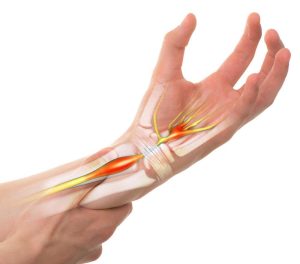


Hand & Wrist Tendon Injuries Treatment in Dubai at Emirates Hospitals Group. Hand and wrist tendon injuries can significantly impact daily activities and overall quality of life. At Emirates Hospitals Group, we pride ourselves on having the best hand and wrist surgeons in Dubai, equipped with extensive expertise and state-of-the-art technology to address these complex injuries. Our team is committed to delivering comprehensive care that includes accurate diagnosis, effective treatment, and personalized rehabilitation to ensure optimal recovery.
- Know About Hand & Wrist Tendon Injuries
- Types of Hand & Wrist Tendon Injuries
- Symptoms & Causes
- Diagnosis & Treatment

Know About Hand & Wrist Tendon Injuries
Tendons are robust, flexible bands of connective tissue that link muscles to bones, enabling movement and providing stability to the joints. In the hand and wrist, tendons play a crucial role in facilitating finger and wrist motions. Injuries to these tendons can result from acute trauma or chronic overuse, affecting the functionality and strength of the hand and wrist. Proper management is essential to restore full function and prevent long-term complications.
Types of Hand & Wrist Tendon Injuries
- Tendon Strains: Overstretching or minor tears in the tendon fibers, often caused by sudden movements or overuse.
- Tendon Ruptures: Complete tears of the tendon, which can occur due to severe trauma or chronic degeneration.
- Tendonitis: Inflammation of a tendon, usually caused by repetitive strain or overuse, leading to pain and swelling.
- Tendinosis: Chronic degeneration of the tendon’s collagen fibers, often resulting from long-term overuse and insufficient healing.
- Flexor Tendon Injuries: Affecting the tendons that allow bending of the fingers and thumb, often resulting from cuts or lacerations.
- Extensor Tendon Injuries: Affecting the tendons responsible for straightening the fingers, frequently caused by trauma or repetitive strain.
Symptoms
Symptoms of hand and wrist tendon injuries vary depending on the type and severity of the injury but commonly include:
- Pain: Localized pain at the site of the injury, which may worsen with movement or pressure.
- Swelling: Noticeable swelling around the affected tendon, often accompanied by warmth and tenderness.
- Reduced Range of Motion: Difficulty moving the affected fingers or wrist, with stiffness and limited mobility.
- Weakness: Decreased strength in the hand or wrist, making it challenging to grasp objects or perform tasks.
- Tenderness: Tenderness to the touch at the site of the injury, particularly around the tendon.
Causes
Hand and wrist tendon injuries can result from various factors, including:
- Acute Trauma: Sudden impact or injury, such as cuts, falls, or direct blows, can cause tendon ruptures or strains.
- Repetitive Strain: Repetitive motions or overuse, especially in activities like typing, sports, or heavy lifting, can lead to tendinitis or tendinosis.
- Chronic Overuse: Prolonged, repetitive activities can result in gradual degeneration of the tendons, causing tendinosis.
- Improper Technique: Incorrect use of tools or sports techniques can place undue stress on tendons, leading to injury.

Diagnosis
Accurate diagnosis of hand and wrist tendon injuries involves several steps:
- Medical History and Physical Examination: A thorough evaluation of the patient’s history, including injury details and symptom assessment, combined with a physical examination to identify pain, swelling, and functional limitations.
- Imaging Studies:
- X-rays: Used to rule out bone fractures or dislocations that may accompany tendon injuries.
- Ultrasound: Provides real-time images of the tendons to detect tears, inflammation, or degeneration.
- MRI (Magnetic Resonance Imaging): Offers detailed images of the soft tissues, including tendons, to assess the extent of injury and guide treatment.
- Functional Tests: Assessing the impact of the injury on hand and wrist function, including grip strength and range of motion.
Treatment
Treatment for hand and wrist tendon injuries at Emirates Hospitals Group is tailored to the specific type and severity of the injury. Our approach includes:
- Non-Surgical Treatments:
- Rest and Immobilization: Using splints or braces to immobilize the affected area and allow the tendon to heal.
- Ice Therapy: Applying ice to reduce swelling and numb pain, typically for 15-20 minutes several times a day.
- Pain Relief: Utilizing over-the-counter or prescribed medications to manage pain and inflammation.
- Physical Therapy: Implementing a rehabilitation program to restore strength, flexibility, and function to the affected tendon.
- Surgical Treatments:
- Tendon Repair Surgery: For complete ruptures or severe tears, surgery may be necessary to reattach or repair the damaged tendon. This procedure is typically performed using minimally invasive techniques for quicker recovery.
- Tendon Reconstruction: In cases of extensive damage or chronic injuries, tendon reconstruction may be performed using grafts or synthetic materials to restore function.
Frequently Asked Questions
A tendon is a connective tissue that links muscles to bones, enabling movement and stability of joints. It is crucial for hand and wrist function.
Symptoms include pain, swelling, reduced range of motion, weakness, and tenderness in the affected area.
Prevention includes using proper techniques during activities, avoiding overuse, and taking regular breaks to reduce strain.
Treatment options include rest, ice therapy, pain relief, physical therapy, and, if necessary, surgical repair or reconstruction.
Recovery time varies depending on the injury’s severity and treatment method, ranging from a few weeks for minor injuries to several months for surgical interventions.
Request an appointment
Please complete the details and we will book you shortly.
Request an appointment
Please complete the details and we will book you shortly.
